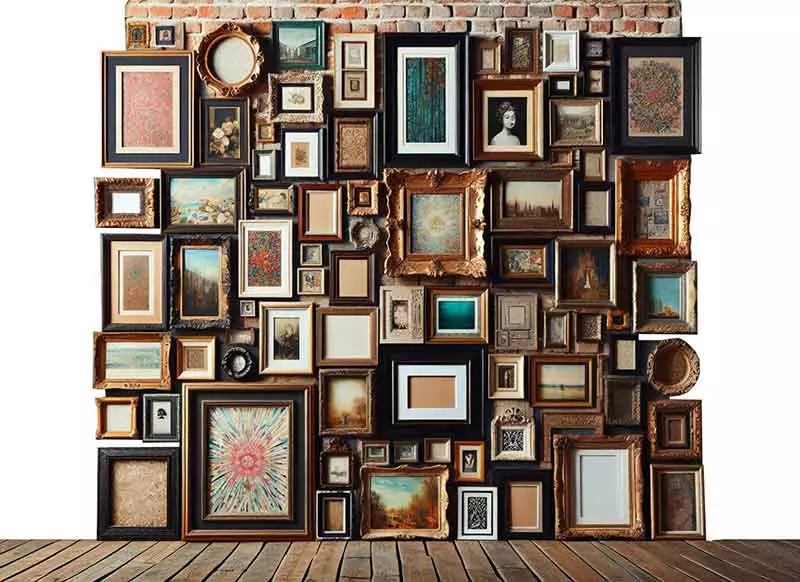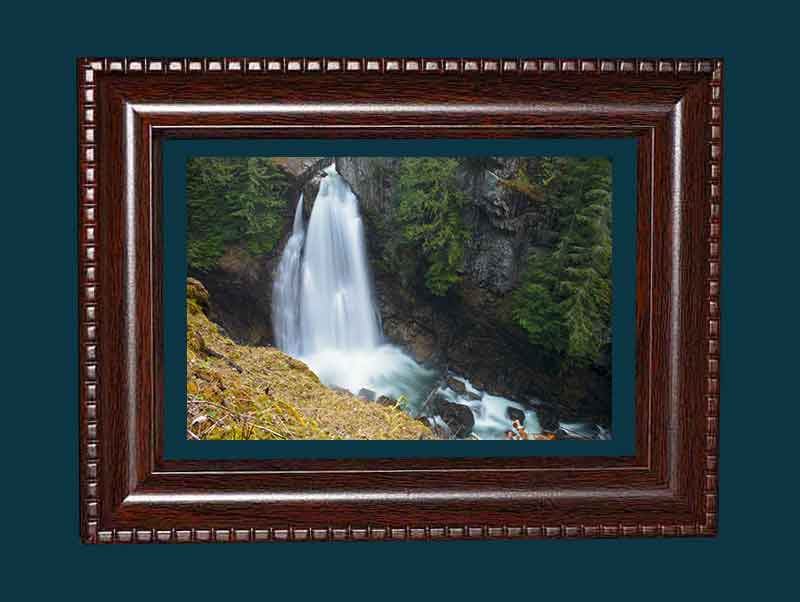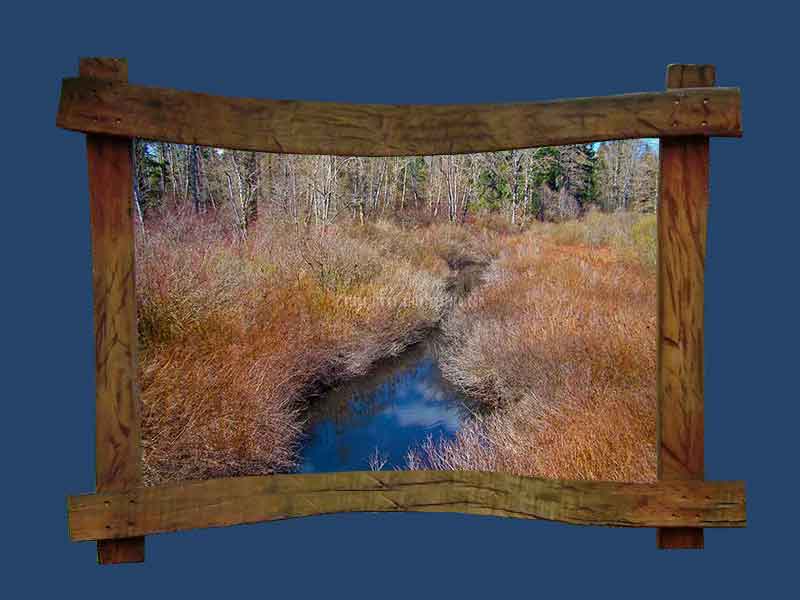- Key Takeaways
- Introduction
- The Anatomy of a Picture Frame
- Types of Picture Frames
- Specialty Picture Frames
- Displaying Picture Frames
- Choosing the Right Frame for Your Photos
- Caring for Your Picture Frames
- DIY Picture Frame Ideas
- Building Your Own Wood Picture Frames
- Summarizing What Are Picture Frames
- Frequently Asked Questions
A picture frame is a border used to display and protect artwork. Paintings or photographs are the most common artwork framed. Picture frames make your photos and paintings look more pleasing. I’ll share my knowledge and tips below on how to choose the right picture frame.
Key Takeaways
Introduction

Picture frames not only enhance the look of paintings or photos but also offer protection. Their dual function is to:
Picture frames, also known as photo frame, make displaying pictures safer and easier.
Picture frames are not only functional but also serve as a significant decor element. They can complement the style of a room, create a cohesive look, and highlight the beauty of the artwork within. Some popular types of picture frames include:
The variety available allows for endless possibilities in terms of style, size, and functionality.
The Anatomy of a Picture Frame
Make yourself familiar with the anatomy of a picture frame. This helps in making an informed choice for your artwork. The rabbet, a groove in the moulding, is where components like the mat board, artwork, and glazing fit in. This groove is essential for keeping everything in place and providing a snug fit for the artwork.
Glazing, usually made of glass or acrylic, serves as a protective layer against:
A mat board, placed between the glazing and artwork, creates a visual border and space, enhancing the image. Mats are also used to prevent the image from touching the glass, adding to the visual appeal.

The backing board is behind the artwork and can be foam board, mat board or pressboard. Dust covers can go behind the backing board to prevent dust or particles getting into the frame. Together, these components ensure that the artwork is well-protected and beautifully presented.
Types of Picture Frames
There is a myriad of picture frames available, each made from different materials and styles, offering unique benefits and aesthetic charm. Traditionally, frames are made of wood, providing strength and allowing for various surface treatments. Metal frames, often silver, bronze or aluminum, are modern and perfect for contemporary spaces.
In recent years digital photo frames, also known as digital picture frame, have become popular because of their ability to display multiple images and easy update with new photos, thanks to technology.
Wooden Frames

Wooden frames have a timeless appeal and can complement various decor styles. Traditionally made of real wood, these frames are strong and beautiful. The natural wood feel can go with any home decor from rustic to modern.
Some wooden frames have elaborate moldings and intricate decorations made of molded and gilded plaster over a wood base. This adds an extra layer of sophistication and glamour, perfect for formal settings. Whether you like a plain frame or an ornate one, wooden frames are versatile and charming.
I personally like wooden frames more than metal ones because of the classic look.
Metal Frames

Metal frames give a modern look and are perfect for contemporary spaces. Common materials for metal frames are silver, bronze and aluminum, each with its own benefits. Aluminum frames are strong, light and rust resistant.
Stainless steel frames are another option, loved for its durability and minimalist look. These frames can give your artwork a clean industrial look perfect for modern and urban-industrial decor. Their thin profile emphasizes the photo, making them a great choice for minimalist displays.
Most of my clients who purchase my work prefer the modern look of metal frames.
Digital Photo Frame

These frames offer the convenience of changing images without the need to print and replace physical photos. Many digital photo frames have WiFi so you can upload images directly from your smartphone or computer.
Besides WiFi connectivity, a digital photo frame also has features like auto slideshow and customizable display settings. Perfect for those who want to display multiple photos in one frame and update the display as often as you want.
I bought a couple of digital photo frames for my family and friends to display my work as gifts.
Specialty Picture Frames
Specialty picture frames cater to unique display needs and artistic preferences, enhancing the visual impact of the framed item. For example, some specialty picture frames include:
Floating Frames
Floating frames use clear glass or acrylic instead of a mat to create the effect of the print floating on the wall. This adds depth and visual interest, makes the artwork look like it’s suspended within the frame. Double panel floating frames, which use two panels of acrylic to sandwich the artwork, create a frameless and borderless presentation.
DIY (do it yourself) floating frames are a great way to add some extra oomph to your decor. By making it look like the artwork is floating in the frame these will draw your eye and add a modern touch to any room.
I used these to display my photos when I first started selling my work in 8×10 size. Unfortunately I broke a lot of them when packing up for transporting to and from shows. Learned how to pack them with protective material to eliminate the problem.
Deep-Set Frames
Deep-set frames are ideal for creating a shadowbox effect, adding significant depth between the picture and the glass. This effect is achieved by using a thicker mat and deep frame to draw the viewer’s eye inward. These frames often feature a profile depth that sets back the photo, mat, and plexiglass by one inch, creating a substantial look.
Handmade to order, deep-set frames can come in various sizes and mat pairings to emphasize different moments. They are particularly well-suited for showcasing landscape or travel photos, creating a sense of escape and drawing the viewer into the scene.
Canvas Prints
Canvas prints are photos printed on high quality cotton blend canvas material, with excellent color and detail reproduction. These prints have texture and depth that traditional photo prints don’t have, perfect for gallery style display. The canvas adds a touch to the art, and makes it pop.
Canvas is used to make big statement pieces that can be the hero of a room. The texture and colour makes them perfect for displaying photos and art in a different way.
Displaying Picture Frames
Strategic display of picture frames is crucial to ensure both functionality and aesthetics, particularly on tabletops. Whether you prefer a gallery wall, tabletop display, or using various wall hanging techniques, the way you display your frames can significantly impact the overall look and feel of a room.
Gallery Walls

Creating a gallery wall involves:
A gallery wall allows for creative expression by mixing and matching frames, photographs, prints, and artwork in a single area. To ensure perfect placement, trace your frames onto paper to create a hanging template before making holes in the wall. Using vertical wall space for a gallery wall frees up tabletop space for other decor or functional items.
Picture ledges offer an alternative method for creating a gallery wall, allowing easy movement and swapping of frames without creating new holes in the wall. This method provides flexibility in arranging and updating your display.
Tabletop Displays
Tabletop frame arrangements can serve as a compelling centerpiece for any room, taking center stage in your display. It’s advisable to display only a few well-placed frames on tabletops to avoid overwhelming the space. Layering frames by positioning some in front of others can add depth to a tabletop display.
Layering a couple of frames on a dresser or shelf can add height and depth to a vignette. Using accessories like candles, small plants, and books can enhance a tabletop frame arrangement. These items can complement the frames and create a more dynamic and visually appealing display.
Wall Hanging Techniques
Using picture-hanging strips can help securely hang frames on walls without damaging the surface. Earthquake putty can be used to secure frames and prevent them from tilting. To ensure straight placement, use painter’s tape to mark where nails should go by pressing the tape on the back of the frame’s mounting hardware.
After hanging, make sure everything is straight with a level. A picture ledge can be used for a gallery wall, allowing easy swaps of art and frames without new nail holes. This technique provides both security and flexibility in displaying your frames.
Choosing the Right Frame for Your Photos
Choosing an apt frame boosts the visual allure of a photograph. When choosing a frame consider the color scheme and style of the room where it will be displayed. Also choose frames that match the subject of the photo to make the image more impactful.
Matching Frame Style with Decor

Choosing a display theme such as a color palette or personal story can guide the selection of frames. Using uniform frame styles and colors can result in a classic and cohesive look, while mixing and matching different frame colors can create a visually appealing display. Black frames can project an elegant and formal feel, while white frames offer a more casual and candid appearance.
Sleek and minimalistic frames are perfect for modern decor, traditional decor pairs well with ornate and classic frame designs. By matching the frame style with the decor you can create a cohesive and beautiful display.
Considering the Photograph’s Subject
Different materials, such as wood or metal, can complement various photo subjects. For black and white photos, almost any frame color can work due to the simplicity of the photo. Using frames in colors that complement the photo’s theme can enhance the visual appeal.
Family portraits look best in simple and elegant frames to keep the focus on the people. Landscape Photos can be enhanced with natural wood frames to add a touch of nature and warmth.
Frame Size and Shape
Knowing the sizes and shapes of picture frames is key to choosing the right frame for your photo. Standard sizes and proportionate to the photo, is the way to not over or under frame the image. Ensuring the frame size matches the photograph helps maintain balance and focus on the content.
Square frames are great for Instagram style photos, modern and trendy. Rectangular frames fit any image, portraits to landscapes. Choose the right size and it’ll be stunning.
Caring for Your Picture Frames
If you want your artwork to last, take good care of your frame. Dust regularly with a soft cloth or feather duster to keep frames clean and debris free. Don’t put picture frames in direct sunlight to prevent UV damage.
For cleaning different types of surfaces, follow these guidelines:
I reccomend you consider professional repairs for any structural issues or significant damage to ensure the longevity of your frames.
DIY Picture Frame Ideas

Personalization and repurposing of picture frames can serve as a creative avenue to mirror personal style and enhance home decor. Here are some ideas for DIY picture frames:
- Refresh old picture frames with a touch of paint, creating DIY painted frames that give them a new lease on life.
- For those who enjoy crafting, custom frames can be made at home without the use of power tools. Try making DIY timber picture frames crafted from scrap wood.
- Another option is to make acrylic frames from sheets and thumbtacks.
There are numerous creative ways to repurpose picture frames, such as:
These are not only a way to show photos but also add a personal touch to your home decor. I used to make my own frames a long time ago but I didn’t have time to shoot photos so I went to a professional who makes his own.
Building Your Own Wood Picture Frames
I used to love building my own wood frames. If you have some spare time and want to give it a go, here is my old notes to get you started:
Materials Required:
- Wood: Choose the type of wood you like. Cedar, Fir, Pine, oak or maple are common.
- Glass: For protecting your picture.
- Backing board: To support the picture.
- Mat board: Optional, for added aesthetics.
- Frame joiners or corner braces: To secure the frame corners.
- Wood glue: For additional frame stability.
- Sandpaper: For smoothing the wood.
- Paint or stain: Optional, for finishing the frame.
Tools Required:
- Miter saw: For 45 degree angles.
- Measuring tape: For measurements.
- Clamps: To hold the frame pieces in place while the glue dries.
- Hammer and nails or brad nailer: To nail the frame corners.
- Glass cutter: For cutting glass to size.
- Ruler and pencil: For marking measurements.
- Router (optional): For creating rabbet and decorative edges.
Time Required:
Time will vary depending on your experience and the frame complexity. A basic frame can take 2-4 hours from start to finish including cutting, assembling and finishing.
Space Required:
A well ventilated space like a garage or large workshop is ideal. You will need enough room to handle the wood, use the miter/router saw safely and for the frame to dry.
Skills Required:
- Measuring and cutting: Basic skills in measuring and cutting wood accurately are essential.
- Assembly: Knowledge of how to join wood pieces securely.
- Finishing: Skills in sanding, painting, or staining wood to achieve a professional look.
- Glass cutting: Ability to cut glass safely to the required size.
- Patience and attention to detail: Ensuring all pieces fit perfectly and are finished neatly.
Step-by-Step Process:
- Measure Artwork: Measure your picture to determine the frame sizes. Don’t forget to measure for the rabbet.
- Cut your wood into lengths using the mitre saw to get the corners to be 45 degrees.
- Use the router to cut the decorative edges and rabbet for your artwork, glass, mat and backing to fit into.
- Nail the frame: Glue the corners and clamp them in place. Nail or brad nail.
- Cut and insert the glass: Carefully cut the glass to size and place it inside the frame.
- Add the backing board: Cut the backing board to fit and secure it in place with frame joiners or corner braces.
- Finish the frame: Sand the frame smooth and apply paint or stain as desired. Allow to dry completely before using.
And you’re done! You have a custom wood frame to hang your favorite pictures or art.
Summarizing What Are Picture Frames
Picture frames are crucial in both protecting and enhancing the visual of photos and artwork. From the anatomy of a picture frame to choosing the right type and style, there’s a lot to consider when picking and displaying frames. Wooden, metal and digital photo frames each have their own benefits and style, and specialty frames like floating and deep set frames give you more options for creative display.
Taking care of your picture frames is key to keeping them in good condition and the artwork inside. Cleaning, no direct sunlight and handling antique frames with care are all important. Customizing and repurposing frames through DIY projects can also add a personal touch to your home decor. Now you can use what you learned here to create beautiful and cohesive displays and keep your memories safe.
